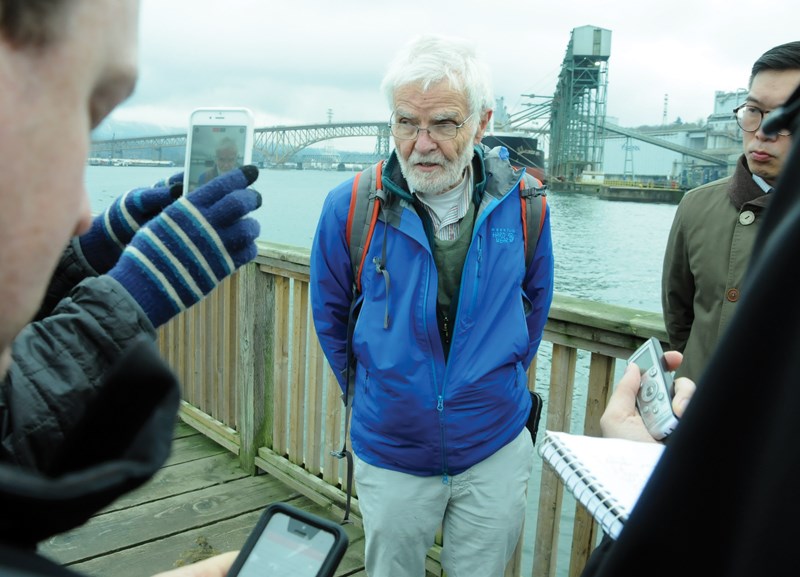A group of retired engineers is accusing the federal government of failing to fully account for the risks of a bitumen-laden aframax tanker drifting off course and colliding with either of the two bridges that span the Second Narrows.
Concerned Professional Engineers, joined by North Shore NOPE and the Tsleil-Waututh Nation council, held a press conference in the shadow of the Ironworkers Memorial Second Narrows Crossing last week, asking the feds to conduct a risk assessment before issuing a decision on Kinder Morgan’s Trans Mountain pipeline application, which is due by Dec. 19.
“I really am terribly upset (about) this idea of a seven-fold increase in tankers through the Second Narrows. It’s a very, very risky project and I’m amazed that the federal government has not taken it upon itself to do a proper risk analysis – what this traffic would mean for the safety of these two bridges,” said Brian Gunn, a retired engineer who once worked on the design of the Roberts Bank terminal.
The group produced an animation depicting the what-if scenario of a tanker experiencing a rudder failure and hitting the CN Rail bridge, and carrying on into the Ironworkers.
“I’m not trying to fear-monger to say this will happen but there may be a strong possibility it could happen,” Gunn said, noting the CN bridge was knocked off its footing by the freighter Japan Erica in 1979. “Rudders can fail. Tugboats can fail. Human beings can fail and we’ve had examples here in the harbour already.”
Specifically, Gunn wants Transport Canada to conduct Canadian Highway Bridge Design Code S6 assessment, which it would do for any new bridge being built.
Eugene Kung, lawyer with West Coast Environmental Law, said it would be “premature” to approve the pipeline project without a new assessment.
“I don’t believe (Kinder Morgan) has done anything to address that in terms of their application or their spill response plan,” he said.
When those issues have been raised in the past, they’ve been met with a “deafening silence,” Kung added.
But assessing the risk of tanker traffic has been accounted for by the Pacific Pilotage Authority, the federal agency charged with safely bringing the ships in and out of the harbour, according to the authority’s director of operations.
“I don’t believe there’s a lack of a risk assessment because we have done our risk assessment in terms of ‘What does it take to navigate these ships safely?’” Young said.
The authority has done “full mission simulations,” which identify risks to navigable feasibility, and what safety mitigations might be put in place. Those assessments included propulsion and steering failures.
For each transiting of the second narrows, the pilotage authority puts two tugs at the ship’s stern and one at the bow and two pilots on the bridge of a ship, one of whom issues orders to the tugs and helmsmen and one who monitors whether those orders are being carried out.
“If we require a forth tug, we’ll order a forth tug as well,” Young said.
The pilots carry independent navigational units that are accurate within a centimetre and can detect changes in course within a 10th of a degree.
“Long before the human eye could identify a vessel beginning to swing one way or the other, the rate-of-turn generator would start and the pilot would see it immediately,” Young said.
Even with only one tug used at the stern in the simulation, the ship stayed on course, Young said.
CN Rail, which owns the rail bridge, declined comment.
Transport Canada deferred to Vancouver Fraser Port Authority
“Ensuring marine safety within our navigational jurisdiction is of paramount importance to the Vancouver Fraser Port Authority,” said Peter Xotta, vice-president of operations. “For about 60 years, tankers have travelled through the Burrard Inlet without oil spill incident, and in that time safety standards have become more stringent.”
According to the province, which has jurisdiction over the Ironworkers, the Ministry of Transportation and Infrastructure will be conducting a “proactive review” for both the Lions Gate and Ironworkers, which is due to be completed in 2017.



